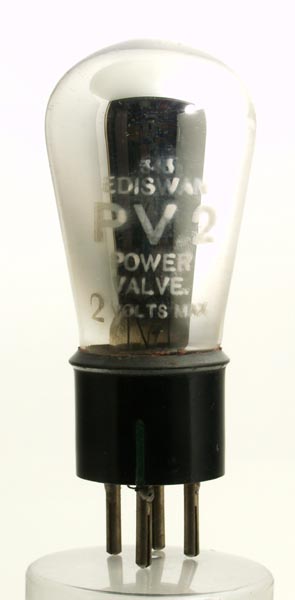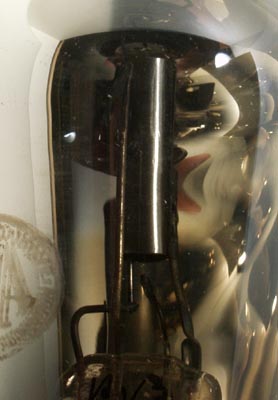
|
The PV2 that we have here is the 1925 later version of the Ediswan PV2. The first valves to carry this type designation were bright emitters. The 1925 dull emitter had a thoriated tungsten filament and the 1928 version had an oxide coated filament.The PV2 was designed as an audio output valve for broadcast receivers at a time when moving armature loudspeakers were the technology of sound reproduction. The moving coil speaker that we know today dates from the late 1920s.On the leaflet that came in the box with the valve it states that the PV2 is 'for loudspeaker work'. The valve is also described as having a window at the top of the bulb so that the filament can be observed. The reason for observing the filament is that although it was suggested that the PV2 be directly connected to a 2 Volt accumulator, the older practice, essential with 'brights', of connecting the filament to the accumulator with a rheostat in series was still possible. The rheostat could be of 6 or 10 Ohms and the filaments should be run at as low a temperature as was compatible with good results.
Although the majority of the envelope is obscured by the Magnesium gettering, it is possible to peek inside at the electrode assembly. The anode is a small cylinder of bright Nickel mounted near to the vertical on stout supports. The helical grid and filament are much harder to see. The rigid construction was deliberate as vibrating electrodes cause microphany and consequent distortion to the sound.The balloon envelope is 41 mm in diameter and, excluding the B4 base pins, is 87 mm tall.References: 1003, Data & 1043. Type PV2 was first introduced in 1926. See also 1926 adverts. |
Pin Connections
| 1 | 2 | 3 | 4 |  a | g1 | f | f |
|
|
Absolute Maximum Operating Conditions¶
| Vh | Ah | Va | Vg | ra | μ | gm | 
| 2.0 | 0.15 | 80-120 | -5 | 9,000 | 6.0 | 0.65 |
|
Updated January 19, 2023.
|
|